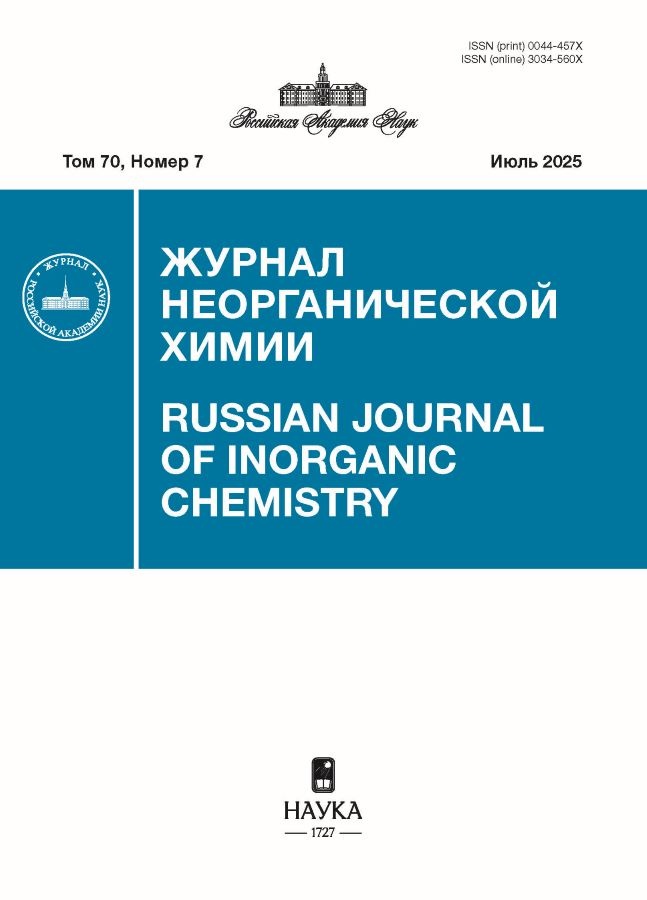Coordination environment strategy for molybdenum(V) porphyrin complexes to improve their sensory parameters
- Авторлар: Motorina E.V.1, Lomova T.N.1
-
Мекемелер:
- G. A. Krestov Institute of Solution Chemistry of the Russian Academy of Sciences
- Шығарылым: Том 70, № 7 (2025)
- Беттер: 904-915
- Бөлім: КООРДИНАЦИОННЫЕ СОЕДИНЕНИЯ
- URL: https://jdigitaldiagnostics.com/0044-457X/article/view/689484
- DOI: https://doi.org/10.31857/S0044457X25070078
- EDN: https://elibrary.ru/JOGASG
- ID: 689484
Дәйексөз келтіру
Аннотация
Molybdenum(V) porphyrin complexes, O=Mo(X)P (P is a substituted porphine, X is a single-charged anionic ligand), show affinity to practically significant organic bases, give an accessible for registration spectral response in the UV-visible region and therefore have prospects as active components of sensor devices. In order to achieve high values of the sensory parameters, the present work analyzes the influence of the composition of the O=Mo(X)P coordination sphere on them by varying the axial ligand X and the substituent in the composition of the equatorial macrocyclic ligand. For this purpose, a complete kinetic description of the reaction with pyridine (Py), a classical example of highly volatile organic compounds (VOCs), proceeding as two consecutive two-way reactions, identification and characterization of the intermediate and final products by UV-visible, 1H NMR, IR spectroscopy and mass spectrometry, and sensing activity parameters — time and numerical value of the spectral response to the presence of Py and the lower limit of determination of the latter is presented using oxo(5,10,15,20-tetraphenylporphinato)(ethoxy)molybdenum(V) (O=Mo(OEt)TРР) as an example. Using similar data for O=Mo(OH)TPP, O=Mo(OEt)TTP and O=Mo(OEt)TtBuPP (TTP and TtBuPP are dianions of tetra-4-methyl- and tetra-4-tert-butyl-substituted TPP, respectively), it is shown that the directed formation of the coordination sphere is a means for fine-tuning the sensory properties and that the complex O=Mo(OEt)TPP is the most effective in this capacity.
Негізгі сөздер
Толық мәтін
Авторлар туралы
E. Motorina
G. A. Krestov Institute of Solution Chemistry of the Russian Academy of Sciences
Хат алмасуға жауапты Автор.
Email: evm@isc-ras.ru
Ресей, Ivanovo, 153045
T. Lomova
G. A. Krestov Institute of Solution Chemistry of the Russian Academy of Sciences
Email: evm@isc-ras.ru
Ресей, Ivanovo, 153045
Әдебиет тізімі
- Paolesse R., Nardis S., Monti D. et al. // Chem. Rev. 2017. V. 117. P. 2517. https://doi.org/10.1021/acs.chemrev.6b00361
- Taihong Liu, Lüjie Yang, Wan Feng et al. // ACS Appl. Mater. Interfaces. 2020. V. 12. Р. 11084. https://doi.org/10.1021/acsami.0c00568
- Evyapan M., Dunbar A.D.F. // Sens. Actuators, B. 2015. V. 206. Р. 74. https://doi.org/10.1016/j.snb.2014.09.023
- Yuanyuan Lv, Yani Zhang, Yanglong Du et al. // Sensors. 2013. V. 13. Р. 15758. https://doi.org/10.3390/s131115758
- Lvova L., Di Natale C., Paolesse R. // Sens. Actuators, B. 2013. V. 179. P. 21. https://doi.org/10.1016/j.snb.2012.10.014
- Shahrokhian S., Taghani A., Hamzehloei A. et al. // Talanta. 2004. V. 63. P. 371. https://doi.org/10.1016/j.talanta.2003.11.007
- Baybars Köksoy, Meryem Aygün, Aylin Çapkin et al. // J. Porphyrins Phthalocyanines. 2018. V. 22. P. 121. https://doi.org/10.1142/S1088424618500153
- Li Tian, Binbin Wang, Ruizhan Chen et al. // Microchim. Acta. 2015. V. 182. P. 687. https://doi.org/10.1007/s00604-014-1374-7
- Paolesse R., Di Natale C., Burgio M. et al. // Sens. Actuators, B. 2003. V. 95. P. 400. https://doi.org/10.1016/S0925-4005(03)00534-3
- C. Henrique A. Esteves, Bernardo A. Iglesias, Takuji Ogawa et al. // ACS Omega. 2018. V. 3. P. 6476. https://doi.org/10.1021/acsomega.8b00403
- Paolesse R., Monti D., Nardis S., Di Natale C. Porphyrin-Based Chemical Sensors. / Eds. Kadish K.M., Smith K.M., Guilard R. Singapore: Worid Scientific, 2011. https://doi.org/10.1142/7878-vol12
- Malinski T. Porphyrin-based Electrochemical Sensors. / Eds. Kadish K.M., Smith K.M., Guilard R. New York: Academic Press, 1999. https://www.sciencedirect.com/book/9780080923901/the-porphyrin-handbook
- Hisanobu Ogoshi, Tadashi Mizutani, Takashi Hayashi, Yasuhisa Kuroda. Porphyrins and metalloporphyrins as Receptor Models in Molecular Recognition. / Eds. Kadish K.M., Smith K.M., Guilard R. New York: Academic Press, 1999. https://www.sciencedirect.com/book/9780080923901/the-porphyrin-handbook
- Басова Т.В., Белых Д.В., Вашурин А.С. и др. // Журн. структур. химии. 2023. Т. 64. № 5. С. 1. https://doi.org/10.26902/JSC_id110058
- Типугина М.Ю., Ломова Т.Н., Моторина Е.В. // Коорд. химия. 2005. Т. 31. № 5. С. 380.
- Моторина Е.В., Климова И.А., Бичан Н.Г., Ломова Т.Н. // Журн. неорган. химии. 2022. Т. 67. № 12. С. 1779. https://doi.org/10.31857/S0044457X22600712
- Lomova T.N., Motorina E.V., Bichan N.G. // J. Porphyrins Phthalocyanines. 2022. V. 26. Р. 485. https://doi.org/10.1142/S1088424622500365
- Lomova T.N. // Appl. Organomet. Chem. 2021. V. 35. e6254. https://doi.org/10.1002/aoc.6254
- Spadavecchia J., Ciccerella G., Rella R. // Sens. Actuators. 2005. V. 106. P. 212. https://doi.org/10.1016/j.snb.2004.08.026
- Motorina E.V., Lomova T.N., Klyuev M.V. // Mendeleev Commun. 2018. V. 28. № 4. P. 426. https://doi.org/10.1016/j.mencom.2018.07.029
- Lomova T.N., Motorina E.V., Mozhzhukhina E.G., Gruzdev M.S. // J. Porphyrins Phthalocyanines. 2020. V. 24. P. 1224. https://doi.org/10.1142/S1088424620500406
- Matsuda Y., Murakami Y. // Coord. Chem. Rev. 1988. V. 92. P. 157.
- Gubarev Y.A., Lebedeva N.Sh., Golubev S.N. et al. // Macroheterocycles. 2013. V. 6. P. 106. https://doi.org/10.6060/mhc120986g
- Medforth C.J. // NMR spectroscopy of diamagnetic porphyrinsin. / Kadish K.M., Smith K.M., Guilard R. New York: Acad. Press, 2000.
- Goutam N., Sabyasachi S. // J. Porphyrins Phthalocyanines. 2014. V. 18. P. 282. https://doi.org/10.1142/S1088424613501277
- Fulmer G.R., Miller A.J.M., Sherden N.H. et al. // Organometallics. 2010. V. 29. P. 2176. https://doi.org/10.1021/om100106e
- Ledon H., Mentzen B. // Inorg. Chim. Acta. 1978. V. 31. P. L393.
- Ledon H., Bonnet M., Brigandat Y., Varescon F. // Inorg. Chem.1980. V. 19. № 11. P. 3488. https://doi.org/10.1021/ic50213a055
- Walker F.A. // J. Am. Chem. Soc. 1973. V. 95. P. 1150.
- Smirnov V.V., Woller E.K., Di Magno S.G. // Inorg. Chem. 1998. V. 37. № 19. P. 4971. https://doi.org/10.1021/ic980156o
- Зайцева С.В., Зданович С.А., Койфман О.И. // Журн. неорган. химии. 2015. Т. 60. № 6. С. 836. https://doi.org/10.7868/S0044457X15060185
- Зайцева С.В., Зданович С.А., Койфман О.И. // Коорд. химия. 2010. Т. 36. № 5. С. 323.
- Yamaji M., Hama Y., Hoshino M. // Chem. Phys. Lett. 1990. V. 165. P. 309. https://doi.org/10.1016/0009-2614(90)87194-v
Қосымша файлдар

















